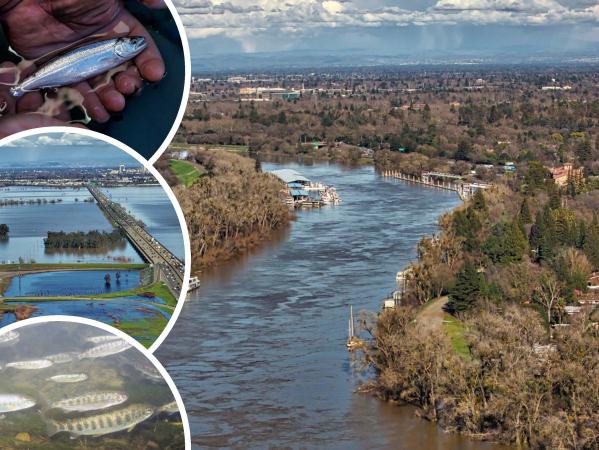April Robinson
April Robinson
Senior Scientist
Resilient Landscapes Program
Carbon, Ecosystems & Climate
Delta Science & Management
510-746-7344
Bio coming soon.
Related Projects, News, and Events
 Assessing Five Watersheds in Santa Clara County (News)
Assessing Five Watersheds in Santa Clara County (News)
A new synthesis report characterizing the amount, distribution, and diversity of streams and wetlands within the County employing CARI, and an ambient survey of the overall ecological condition of streams employing CRAM.
Constraints on primary production and the relative importance of different production sources to the food web remain major uncertainties in the Delta ecosystem. Newly available spatial data developed as part of the Delta Historical Ecology and Delta Landscapes projects make it possible to explore the effects of landscape configuration and hydrodynamics on primary production in a way that was not previously possible. Proposed order-of-magnitude calculations estimating primary production can ‘bookend’ the potential magnitude of production in the Delta, and inform what is possible in terms of restoration and management options.
 Santa Rosa Plain Wetlands Profile: A Demonstration of WRAMP (Project)
Santa Rosa Plain Wetlands Profile: A Demonstration of WRAMP (Project)
The Santa Rosa Plain WRAMP project demonstrated the use of the State’s standardized monitoring and assessment tools in a North Coast watershed setting and described how the results can support watershed based management and planning decisions to protect and manage the state’s wetlands at a landscape scale.
 Delta Salmon Rearing (Project)
Delta Salmon Rearing (Project)
The objective of this project is to summarize existing research and knowledge around suitable rearing habitat for Chinook salmon in the Sacramento-San Joaquin Delta; identify areas of suitability for rearing salmon using a combined suitability analysis of four mapped habitat parameters; and to provide recommendations for types of restoration needed to improve or restore rearing habitat, as well as to identify where in the Delta these restoration efforts could be prioritized.
 Delta Landscapes Project (Project)
Delta Landscapes Project (Project)
The Delta Landscapes Project, which began in 2012 and will run through 2016, has developed a body of work to inform landscape-scale restoration of the Sacramento-San Joaquin Delta ecosystem.
The San Francisco Estuary Partnership (SFEP) brings together the estuarine community every two years at the State of the Estuary Conference and, periodically, SFEP also reports on the State of the Estuary, summarizing the latest scientific findings about ecosystem health. This State of the Estuary Report is the only place where a holistic view of ecosystem function is provided across both the Bay and the Delta. This year, SFEI provided scientific leadership and technical support for the report, which focuses on the ties between social and ecological resilience for our estuary.
 California Rapid Assessment Method (CRAM) (Project)
California Rapid Assessment Method (CRAM) (Project)
CRAM is a standardized, scientifically defensible rapid assessment method for monitoring the ecological conditions of wetlands throughout California. Because it is standardized, one can compare ecological conditions of wetlands locally, regionally and statewide.
 New paper: Building resilience in highly modified California landscapes (News)
New paper: Building resilience in highly modified California landscapes (News)
SFEI has released a new paper in the journal BioScience, "Building ecological resilience in highly modified landscapes." The paper, led by Erin Beller of the Resilient Landscapes team in collaboration with a group of international ecologists, presents a new framework for applying ecological resilience science to landscape-scale management, with examples from SFEI's work in urban and agricultural California landscapes.
 SFEI is working with the Santa Clara Valley Water District to develop multi-benefit management tools (News)
SFEI is working with the Santa Clara Valley Water District to develop multi-benefit management tools (News)
In 2014, SFEI and the Santa Valley Water District launched a collaborative partnership aimed at sharing experience, knowledge and resources, and working toward a shared vision of watershed management. Through this partnership, the District has asked SFEI to develop a set of online tools to: 1) identify opportunities for multi-benefit management actions in and along the channels managed by the District; and 2) track the impacts of those actions towards meeting established management targets.
 South Bay Landscape Vision Workshop (News)
South Bay Landscape Vision Workshop (News)
On June 7, SFEI, in partnership with the Santa Clara Valley Water District and South Bay Salt Ponds Restoration Project, hosted a landscape “visioning” workshop in San Jose. The goal of the workshop was to develop a resilient, multi-benefit vision highlighting opportunities along the South Bay shoreline for supporting both tidal marsh restoration and flood management.
 SFEI work on Landscape Resilience and Urban Biodiversity featured in Google Blog and Fast Company Story (News)
SFEI work on Landscape Resilience and Urban Biodiversity featured in Google Blog and Fast Company Story (News)
Our partnership with Google to enhance the ecological resilience of urban landscapes is featured in a story by Fast Company, a Google Blog post, and an accompanying video.
 California Rapid Assessment Method (CRAM): Bar-Built Estuarine Wetlands (Project)
California Rapid Assessment Method (CRAM): Bar-Built Estuarine Wetlands (Project)
The CRAM Bar-Built Estuarine module is used for assessing reaches of coastal rivers and streams that are ecologically influenced by seasonal closures of their tidal inlets.
CRAM is a cost-effective and scientifically defensible rapid assessment method for monitoring and assessing the ecologcial conditions of wetlands throughout California. It takes less than half a day to assess a wetland area, and is designed evaluate the condition of the wetland based on it's landscape setting, hydrology, physical structure and biological structure. Because the methodology is standardized for over seven types of wetlands, ecological condition scores can be compared at the local, regional and statewide landscape scales.
SFEI recently released a resilient landscape vision for lower Novato Creek that incorporates habitat restoration actions into flood risk management. The vision, developed in coordination with a team of regional science experts, highlights opportunities for restoring and sustaining vital tidal wetland habitats around lower Novato Creek while supporting a high level of flood protection under rising San Francisco Bay water levels.
- ‹ previous
- 2 of 2

